2014 Peugeot Boxer ECO mode
[x] Cancel search: ECO modePage 4 of 240
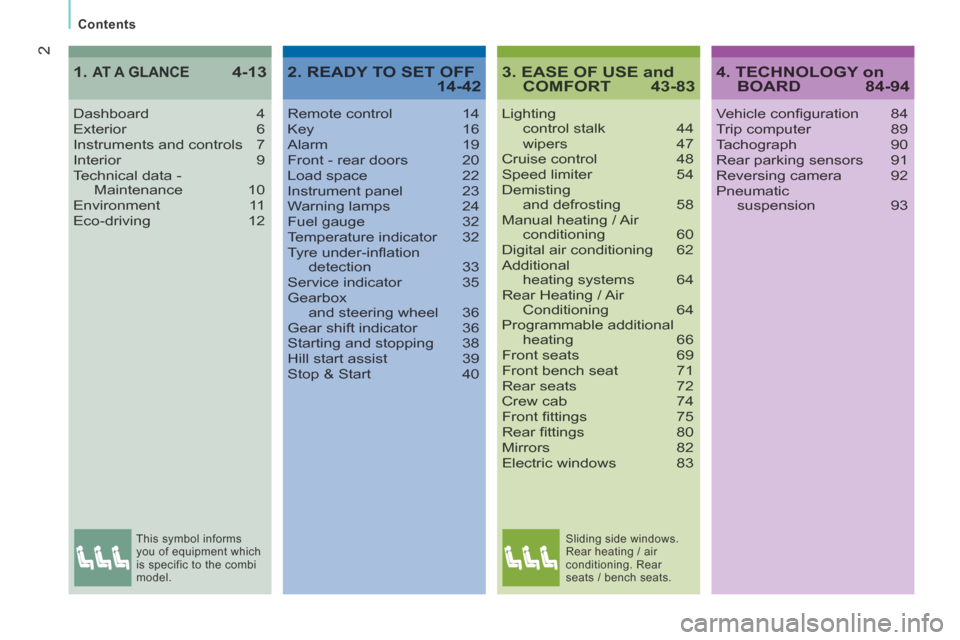
2
Contents
3. EASE OF USE and COMFORT 43-83
Lighting control stalk 44 wipers 47Cruise control 48Speed limiter 54Demisting and defrosting 58Manual heating / Air conditioning 60Digital air conditioning 62Additional heating systems 64Rear Heating / Air Conditioning 64Programmable additional heating 66Front seats 69Front bench seat 71Rear seats 72Crew cab 74Front fi ttings 75Rear fi ttings 80Mirrors 82Electric windows 83
Dashboard 4Exterior 6Instruments and controls 7Interior 9Technical data - Maintenance 10Environment 11Eco-driving 12
1. AT A GLANCE 4-134. TECHNOLOGY on BOARD 84-94
Vehicle confi guration 84Trip computer 89Tachograph 90Rear parking sensors 91Reversing camera 92Pneumatic suspension 93
2. READY TO SET OFF 14-42
Remote control 14Key 16Alarm 19Front - rear doors 20Load space 22Instrument panel 23Warning lamps 24Fuel gauge 32Temperature indicator 32Tyre under-infl ation detection 33Service indicator 35Gearbox and steering wheel 36Gear shift indicator 36Starting and stopping 38Hill start assist 39Stop & Start 40
This symbol informs
you of equipment which
is specific to the combi
model. Sliding side windows.
Rear heating / air
conditioning. Rear
seats / bench seats.
Page 21 of 240
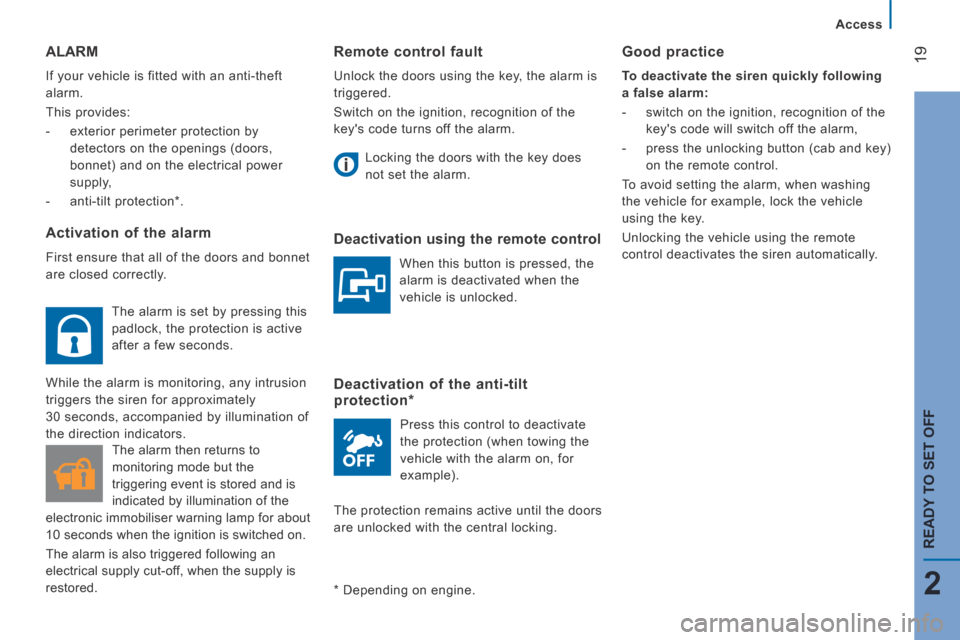
19
2
Access
READY TO SET OFF
Remote control fault
Unlock the doors using the key, the alarm is
triggered.
Switch on the ignition, recognition of the
key's code turns off the alarm. Locking the doors with the key does
not set the alarm.
Deactivation using the remote control
When this button is pressed, the
alarm is deactivated when the
vehicle is unlocked.
Deactivation of the anti-tilt protection *
Press this control to deactivate
the protection (when towing the
vehicle with the alarm on, for
example).
The protection remains active until the doors
are unlocked with the central locking.
ALARM
If your vehicle is fitted with an anti-theft
alarm.
This provides:
- exterior perimeter protection by detectors on the openings (doors,
bonnet) and on the electrical power
supply,
- anti-tilt protection * .
Activation of the alarm
First ensure that all of the doors and bonnet
are closed correctly.
* Depending on engine.
Good practice
To deactivate the siren quickly following
a false alarm:
- switch on the ignition, recognition of the key's code will switch off the alarm,
- press the unlocking button (cab and key) on the remote control.
To avoid setting the alarm, when washing
the vehicle for example, lock the vehicle
using the key.
Unlocking the vehicle using the remote
control deactivates the siren automatically.
The alarm is set by pressing this
padlock, the protection is active
after a few seconds.
While the alarm is monitoring, any intrusion
triggers the siren for approximately
30 seconds, accompanied by illumination of
the direction indicators. The alarm then returns to
monitoring mode but the
triggering event is stored and is
indicated by illumination of the
electronic immobiliser warning lamp for about
10 seconds when the ignition is switched on.
The alarm is also triggered following an
electrical supply cut-off, when the supply is
restored.
Page 31 of 240
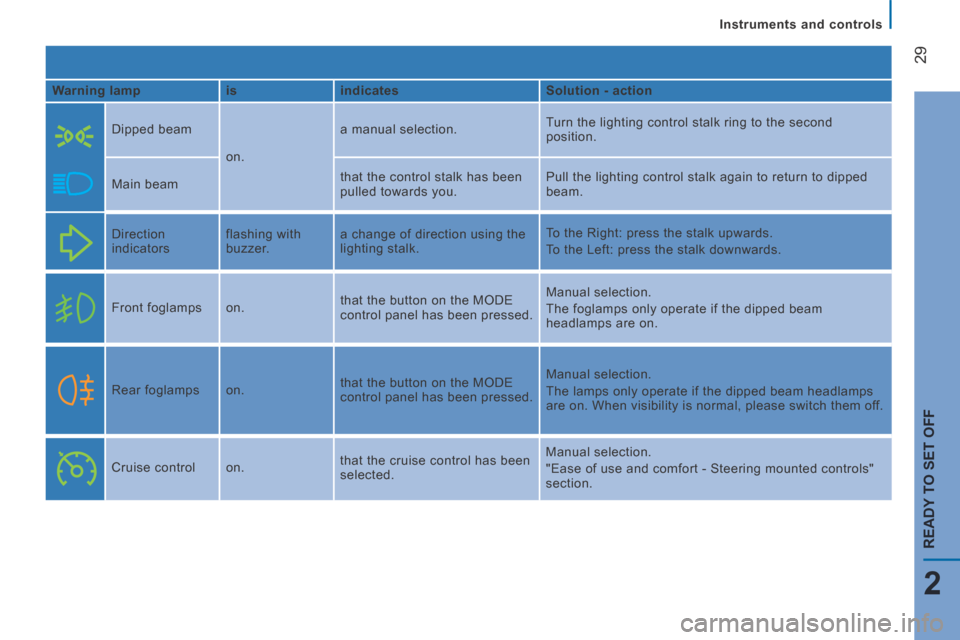
29
2
READY TO SET OFF
Instruments and controls
Warning lamp is indicates Solution - action
Dipped beam
on. a manual selection.
Turn the lighting control stalk ring to the second
position.
Main beam that the control stalk has been
pulled towards you. Pull the lighting control stalk again to return to dipped
beam.
Direction
indicators flashing with
buzzer. a change of direction using the
lighting stalk. To the Right: press the stalk upwards.
To the Left: press the stalk downwards.
Front foglamps on. that the button on the MODE
control panel has been pressed. Manual selection.
The foglamps only operate if the dipped beam
headlamps are on.
Rear foglamps on. that the button on the MODE
control panel has been pressed. Manual selection.
The lamps only operate if the dipped beam headlamps
are on. When visibility is normal, please switch them off.
Cruise control on. that the cruise control has been
selected. Manual selection.
"Ease of use and comfort - Steering mounted controls"
section.
Page 32 of 240
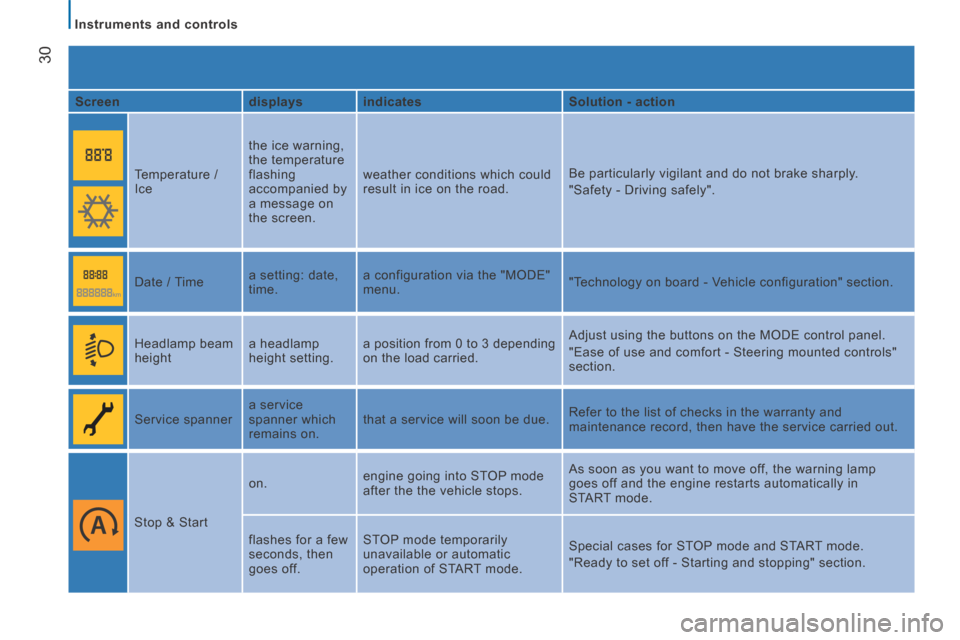
30
Instruments and controls
Screen displays indicates Solution - action
Temperature /
Ice the ice warning,
the temperature
flashing
accompanied by
a message on
the screen. weather conditions which could
result in ice on the road.
Be particularly vigilant and do not brake sharply.
"Safety - Driving safely".
Date / Time a setting: date,
time. a configuration via the "MODE"
menu.
"Technology on board - Vehicle configuration" section.
Headlamp beam
height a headlamp
height setting. a position from 0 to 3 depending
on the load carried . Adjust using the buttons on the MODE control panel.
"Ease of use and comfort - Steering mounted controls"
section.
Service spanner a service
spanner which
remains on. that a service will soon be due.
Refer to the list of checks in the warranty and
maintenance record, then have the service carried out.
Stop & Start on.
engine going into STOP mode
after the the vehicle stops. As soon as you want to move off, the warning lamp
goes off and the engine restarts automatically in
START mode.
flashes for a few
seconds, then
goes off. STOP mode temporarily
unavailable or automatic
operation of START mode.
Special cases for STOP mode and START mode.
"Ready to set off - Starting and stopping" section.
Page 37 of 240
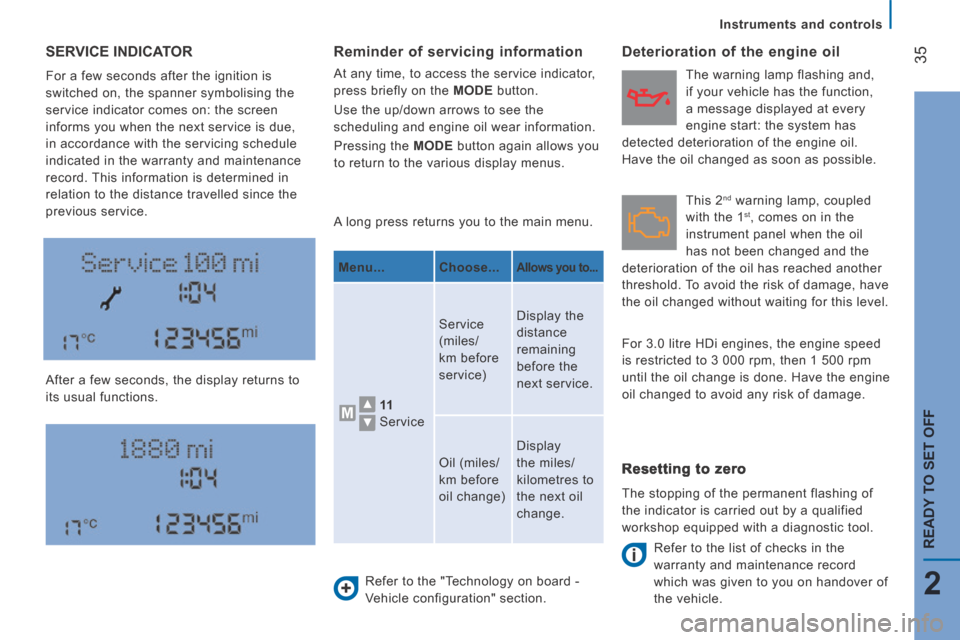
35
2
READY TO SET OFF
Instruments and controls
SERVICE INDICATOR
For a few seconds after the ignition is
switched on, the spanner symbolising the
service indicator comes on: the screen
informs you when the next service is due,
in accordance with the servicing schedule
indicated in the warranty and maintenance
record. This information is determined in
relation to the distance travelled since the
previous service.
After a few seconds, the display returns to
its usual functions. A long press returns you to the main menu.
Refer to the "Technology on board -
Vehicle configuration" section.
Deterioration of the engine oil
Refer to the list of checks in the
warranty and maintenance record
which was given to you on handover of
the vehicle.
Reminder of servicing information
At any time, to access the service indicator,
press briefly on the MODE button.
Use the up/down arrows to see the
scheduling and engine oil wear information.
Pressing the MODE button again allows you
to return to the various display menus.
Menu... Choose...
Allows you to...
11
Service Service
(miles/
km before
service)
Display the
distance
remaining
before the
next service.
Oil (miles/
km before
oil change) Display
the miles/
kilometres to
the next oil
change.
Resetting to zero
The stopping of the permanent flashing of
the indicator is carried out by a qualified
workshop equipped with a diagnostic tool. This 2
nd warning lamp, coupled
with the 1 st , comes on in the
instrument panel when the oil
has not been changed and the
deterioration of the oil has reached another
threshold. To avoid the risk of damage, have
the oil changed without waiting for this level. The warning lamp flashing and,
if your vehicle has the function,
a message displayed at every
engine start: the system has
detected deterioration of the engine oil.
Have the oil changed as soon as possible.
For 3.0 litre HDi engines, the engine speed
is restricted to 3 000 rpm, then 1 500 rpm
until the oil change is done. Have the engine
oil changed to avoid any risk of damage.
Page 42 of 240
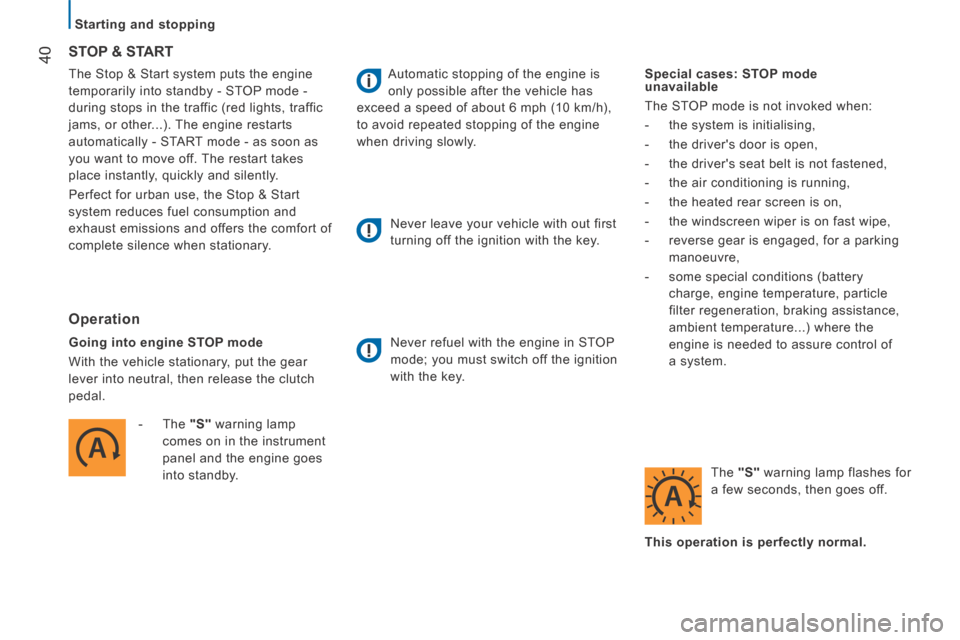
40
Starting and stopping
The Stop & Start system puts the engine
temporarily into standby - STOP mode -
during stops in the traffic (red lights, traffic
jams, or other...). The engine restarts
automatically - START mode - as soon as
you want to move off. The restart takes
place instantly, quickly and silently.
Perfect for urban use, the Stop & Start
system reduces fuel consumption and
exhaust emissions and offers the comfort of
complete silence when stationary.
STOP & START
Operation
Going into engine STOP mode
With the vehicle stationary, put the gear
lever into neutral, then release the clutch
pedal. - The "S" warning lamp comes on in the instrument
panel and the engine goes
into standby. Automatic stopping of the engine is
only possible after the vehicle has
exceed a speed of about 6 mph (10 km/h),
to avoid repeated stopping of the engine
when driving slowly.
Never leave your vehicle with out first
turning off the ignition with the key.
Never refuel with the engine in STOP
mode; you must switch off the ignition
with the key. Special cases: STOP mode
unavailable
The STOP mode is not invoked when:
- the system is initialising,
- the driver's door is open,
- the driver's seat belt is not fastened,
- the air conditioning is running,
- the heated rear screen is on,
- the windscreen wiper is on fast wipe,
- reverse gear is engaged, for a parking
manoeuvre,
- some special conditions (battery charge, engine temperature, particle
filter regeneration, braking assistance,
ambient temperature...) where the
engine is needed to assure control of
a system.
The "S" warning lamp flashes for
a few seconds, then goes off.
This operation is perfectly normal.
Page 43 of 240
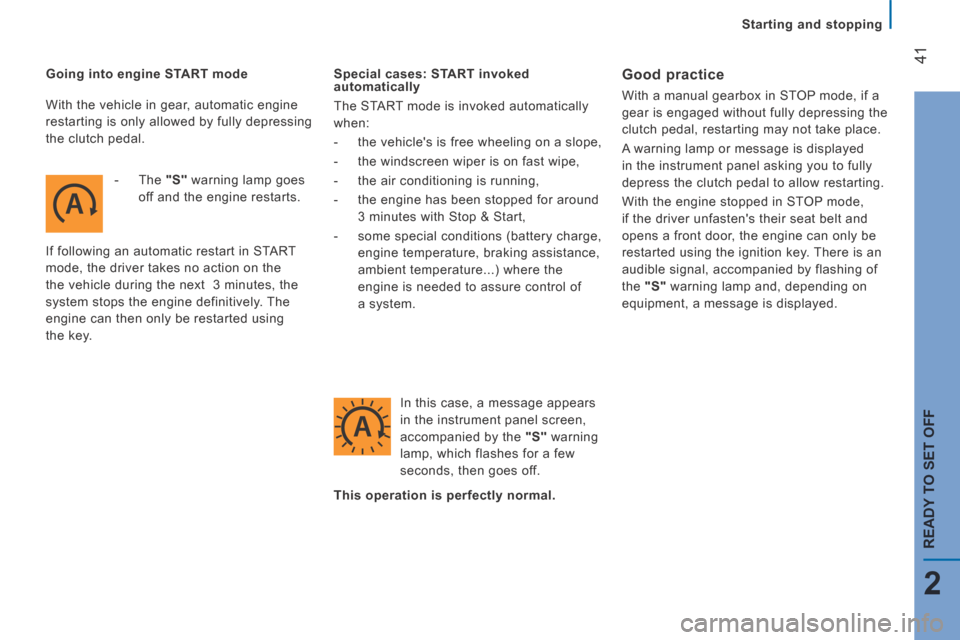
41
2
READY TO SET OFF
Starting and stopping
Going into engine START mode - The "S" warning lamp goes off and the engine restarts.
If following an automatic restart in START
mode, the driver takes no action on the
the vehicle during the next 3 minutes, the
system stops the engine definitively. The
engine can then only be restarted using
the key. Special cases: START invoked
automatically
The START mode is invoked automatically
when:
- the vehicle's is free wheeling on a slope,
- the windscreen wiper is on fast wipe,
- the air conditioning is running,
- the engine has been stopped for around
3 minutes with Stop & Start,
- some special conditions (battery charge, engine temperature, braking assistance,
ambient temperature...) where the
engine is needed to assure control of
a system.
In this case, a message appears
in the instrument panel screen,
accompanied by the "S" warning
lamp, which flashes for a few
seconds, then goes off. Good practice
With a manual gearbox in STOP mode, if a
gear is engaged without fully depressing the
clutch pedal, restarting may not take place.
A warning lamp or message is displayed
in the instrument panel asking you to fully
depress the clutch pedal to allow restarting.
With the engine stopped in STOP mode,
if the driver unfasten's their seat belt and
opens a front door, the engine can only be
restarted using the ignition key. There is an
audible signal, accompanied by flashing of
the "S" warning lamp and, depending on
equipment, a message is displayed.
This operation is perfectly normal.
With the vehicle in gear, automatic engine
restarting is only allowed by fully depressing
the clutch pedal.
Page 63 of 240
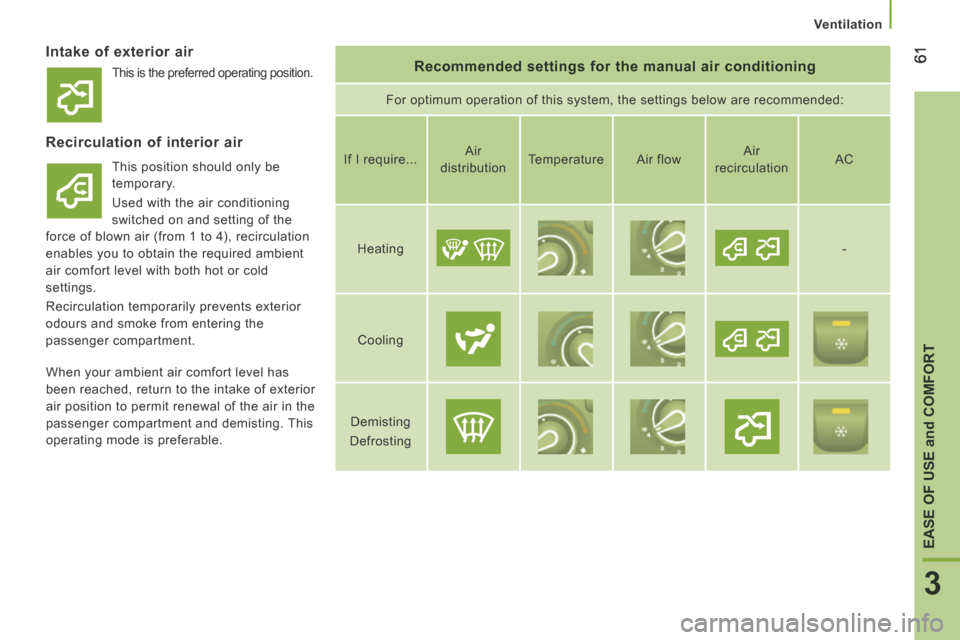
61
3
EASE OF USE
and
COMFORT
Ventilation
Intake of exterior air Recommended settings for the manual air conditioning
For optimum operation of this system, the settings below are recommended\
:
Recirculation of interior air
This position should only be
temporary.
Used with the air conditioning
switched on and setting of the
force of blown air (from 1 to 4), recirculation
enables you to obtain the required ambient
air comfort level with both hot or cold
settings.
Recirculation temporarily prevents exterior
odours and smoke from entering the
passenger compartment. If I require...
Air
distribution Temperature
Air flow Air
recirculation AC
Heating -
Cooling
Demisting
Defrosting
When your ambient air comfort level has
been reached, return to the intake of exterior
air position to permit renewal of the air in the
passenger compartment and demisting. This
operating mode is preferable.
This is the preferred operating position.